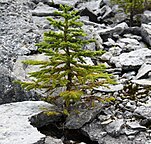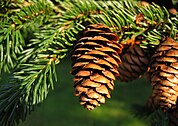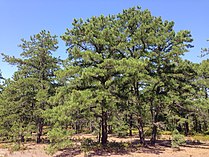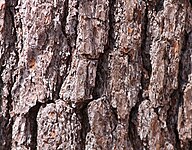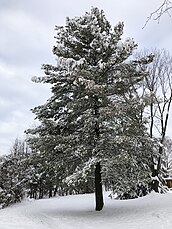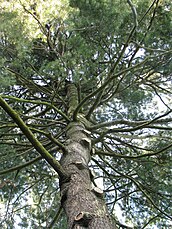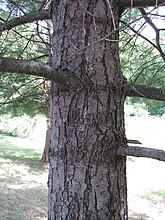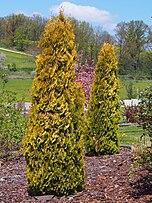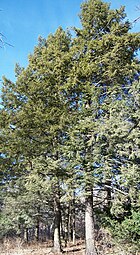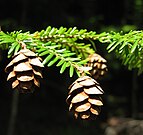User:Dank/List of forest-inventory conifers east of the Mississippi

Silvics of North America (1991),[1] a forest inventory compiled and published by the United States Forest Service, includes many conifers in states east of the Mississippi River.[a] It superseded Silvics of Forest Trees of the United States (1965), which was the first extensive American tree inventory.[3]
All of the conifers in the inventory except the larches and some bald cypresses are evergreens.[4] Apart from two species in the yew family, all are in either the pine family (including firs, larches, spruces, pines, Douglas firs and hemlocks) or the cypress family (including junipers, redwoods, giant sequoias, bald cypresses and four genera of cedars).[2][5][6][b]
Softwood from North American conifers has a variety of commercial uses. The sturdier timber is used for plywood, wood veneer and construction framing, including structural support beams and studs. Milled logs can be fashioned into posts, poles and railroad ties. Less sturdy timber is often ground and processed into pulpwood, principally for papermaking. Resins from sap yield pine tar, turpentine and other terpenes.[7]
Key
[edit]
States in this list (see the Distribution column): AL Alabama CT Connecticut DE Delaware FL Florida GA Georgia IL Illinois IN Indiana KY Kentucky MA Massachusetts MD Maryland ME Maine MI Michigan MS Mississippi NC North Carolina NH New Hampshire NJ New Jersey NY New York OH Ohio PA Pennsylvania RI Rhode Island TN Tennessee VA Virginia VT Vermont WI Wisconsin WV West Virginia
These are often divided up into
- New England: CT MA ME NH RI VT
- The Mid-Atlantic: DE MD NJ NY PA VA WV
- The Southeast: AL FL GA MS NC SC TN (not including KY)
- The Midwestern states east of the Mississippi, sometimes called the eastern Midwest: IL IN MI OH WI
Conifers
[edit]| Species and a common name[2][8][9] | Notes and commercial uses | Distribution[9]
avg height; |
Limits for soil pH, annual precipitation and low temperature | Tolerance: (D)rought (F)ire, (L)iming and (S)hade |
Landscapes, bark and cones with foliage |
|---|---|---|---|---|---|
| Abies balsamea (balsam fir) | A significant source of food and shelter for wildlife. Horizontal blisters in the bark contain aromatic Canada balsam.
Uses: construction, landscaping, pulpwood, terpenes, veneers, winter holiday decorations[10][11] |
IN MI OH WI, New England and the Mid-Atlantic except for DE
—
60 ft (18 m); slow[10] |
pH 4.0–6.0
13–60 in (33–152 cm) |
D: low F: low L: low S: tolerant [10] |
|
| Abies fraseri (Fraser fir) | The only fir with a range limited to the southern Appalachians. It provides watershed protection, and is grown commercially for winter holidays.
Uses: landscaping, pulpwood, veneers, winter holiday decorations[12][13] |
GA NC TN VA
—
55 ft (17 m); moderate[12] |
pH 3.5–5.5
45–100 in (110–250 cm) |
D: low F: low L: low S: tolerant [12] |
|
| Chamaecyparis thyoides (Atlantic white cedar) | Usually found in swamps and marshes. The decay-resistant wood retains commercial value in the Southeast, although harvesting has considerably reduced its acreage. | AL MS and every state on the Atlantic coast
—
50 ft (15 m); moderate[14] |
pH 3.5–6.3
40–70 in (100–180 cm) |
D: none F: medium L: none S: medium [14] |
|
| Picea rubens (red spruce) | The straight-grained wood is lightweight but strong. It is the most popular choice in many stringed instruments for its resonance.
Uses: construction, posts, pulpwood, terpenes, veneers[16][17] |
NC TN, the Mid-Atlantic except for DE, and New England except for RI
—
110 ft (34 m); moderate[16] |
pH 4.0–5.8
28–52 in (71–132 cm) |
D: medium F: none L: low S: tolerant [16] |
|
| Pinus nigra (Austrian pine) | Not a native tree, but it has been in cultivation in the US since the 1700s for timber and as an ornamental tree. Its range may extend slightly west of the Mississippi.
Uses: landscaping, veneers, winter holiday decorations[18][19] |
IL MA MD ME MI MS NJ NY OH PA
—
120 ft (37 m); moderate[18] |
pH 5.5–7.5
35–50 in (89–127 cm) |
D: medium F: low L: high S: intolerant [18] |
|
| Pinus pungens (Table Mountain pine) | Mostly valued for watershed management and pulpwood. | GA IL MD NC NJ PA SC TN VA WV
—
|
pH 4.5–7.0
36–60 in (91–152 cm) |
D: high F: low L: low S: intolerant [20] |
|
| Pinus resinosa (red pine) | One of the fastest-growing conifer species. The wood is straight-grained and moderately hard. Some of it is milled for railroad ties and cabin logs.
Uses: construction, landscaping, posts, pulpwood, veneers, winter holiday decorations[22][23] |
IL IN NC WI, New England and the Mid-Atlantic except for DE
—
80 ft (24 m); rapid[22] |
pH 4.5–6.0
15–60 in (38–152 cm) |
D: low F: low L: none S: intolerant [22] |
|
| Pinus rigida (pitch pine) | Rigida (rigid) refers to the needles and cone scales. The wood, resinous and rot-resistant, is suitable for shipbuilding, mine timbers, fencing and railroad ties.
Uses: landscaping, posts, pulpwood, terpenes, winter holiday decorations[24][25] |
GA IL IN KY NC OH SC TN, the Mid-Atlantic and New England
—
80 ft (24 m); rapid[24] |
pH 3.5–5.1
37–56 in (94–142 cm) |
D: medium F: low L: low S: intolerant [24] |
|
| Pinus serotina (pond pine) | Valued as a tree that produces pulpwood in wetter conditions than most pines will tolerate. | DE MD NJ VA and the Southeast except for TN and MS
—
80 ft (24 m); moderate[26] |
pH 4.8–6.8
40–60 in (100–150 cm) |
D: none F: medium L: medium S: intolerant [26] |
|
| Pinus strobus (eastern white pine) | One of the most commercially important trees in eastern North America, in part due to its rapid growth. The timber is durable but soft enough for woodworking.
Uses: construction, landscaping, posts, pulpwood, veneers, winter holiday decorations[28][29] |
All states east of the Mississippi except FL and MS
—
150 ft (46 m); rapid[28] |
pH 4.0–6.5
20–80 in (51–203 cm) |
D: none F: none L: none S: medium [28] |
|
| Pinus sylvestris (Scots pine) | The most widely planted non-native pine species in North America, valued for winter holidays and erosion control as well as pulpwood. Its range may extend slightly west of the Mississippi.
Uses: landscaping, pulpwood, winter holiday decorations[30][31] |
New England, the eastern Midwest and the Mid-Atlantic except for VA and WV
—
110 ft (34 m); rapid[30] |
pH 5.0–7.5
24–45 in (61–114 cm) |
D: medium F: low L: low S: intolerant [30] |
|
| Thuja occidentalis (arborvitae) | The termite- and rot-resistant wood, durable in a range of outdoor conditions, is used in fencing, cabin logs and roof shingles.
Uses: construction, landscaping, posts, pulpwood, veneers[5][6] |
NC SC TN, the eastern Midwest, New England, and the Mid-Atlantic except for DE
—
50 ft (15 m); slow[5] |
pH 5.2–7.0
35–55 in (89–140 cm) |
D: low F: low L: high S: medium [5] |
|
| Torreya taxifolia (Florida nutmeg) | An endangered evergreen in the yew family.
Uses: landscaping, posts, winter holiday decorations[32][33] |
FL GA
—
40 ft (12 m); moderate[32] |
pH 5.0–7.0
30–60 in (76–152 cm) |
D: low F: none L: medium S: tolerant [32] |
Seed and foliage pictured, lower right (not cone) |
| Tsuga canadensis (eastern hemlock) | Shade-tolerant, long-lived and slow-growing. Historically, it provided tannin for curing leather. | IN MI OH WI, the Mid-Atlantic, New England and the Southeast except for FL and MS
—
105 ft (32 m); slow[34] |
pH 4.2–5.7
32–55 in (81–140 cm) |
D: low F: medium L: none S: tolerant [34] |
See also
[edit]Notes
[edit]- ^ Excluding the state of Minnesota, which is partially divided by the river. The taxonomy (classification) on this page comes from Plants of the World Online except as noted, and omits hybrids and varieties.[2] The 1991 inventory has limited coverage outside Canada and the continental United States, and is not used outside these areas in this list.[3]
- ^ Alaska cedars, incense cedars, white cedars and thuja cedars
Citations
[edit]- ^ Burns & Honkala 1991.
- ^ a b c POWO.
- ^ a b Burns & Honkala 1991, pp. i–vi.
- ^ National Plant Data Team 2024, Characteristics, Leaf Retention.
- ^ a b c d e National Plant Data Team 2024, Thuja occidentalis: Plant Guide; Characteristics.
- ^ a b Johnston 1991, pp. 580, 587.
- ^ National Plant Data Team 2024, Help Document.
- ^ Burns & Honkala 1991, pp. v–vi.
- ^ a b National Plant Data Team 2024.
- ^ a b c d National Plant Data Team 2024, Abies balsamea: Fact Sheet; Characteristics.
- ^ Frank 1991, pp. 26–34.
- ^ a b c d National Plant Data Team 2024, Abies fraseri: Characteristics.
- ^ Beck 1991, pp. 47–51.
- ^ a b c d National Plant Data Team 2024, Chamaecyparis thyoides: Characteristics.
- ^ Zobel 1991, pp. 88–96.
- ^ a b c d National Plant Data Team 2024, Picea rubens: Fact Sheet; Characteristics.
- ^ Blum 1991, pp. 250–259.
- ^ a b c d National Plant Data Team 2024, Pinus nigra: Characteristics.
- ^ Van Haverbeke 1991, pp. 395–404.
- ^ a b c d National Plant Data Team 2024, Pinus pungens: Characteristics.
- ^ a b Della-Bianca 1991, pp. 425–432.
- ^ a b c d National Plant Data Team 2024, Pinus resinosa: Plant Guide; Characteristics.
- ^ Rudolf 1991, pp. 442–455.
- ^ a b c d National Plant Data Team 2024, Pinus rigida: Characteristics.
- ^ Little & Garrett 1991, pp. 456–462.
- ^ a b c d National Plant Data Team 2024, Pinus serotina: Characteristics.
- ^ Bramlett 1991, pp. 470–475.
- ^ a b c d National Plant Data Team 2024, Pinus strobus: Fact Sheet; Characteristics.
- ^ Wendel & Smith 1991, pp. 476–488.
- ^ a b c d National Plant Data Team 2024, Pinus sylvestris: Characteristics.
- ^ Skilling 1991, pp. 489–496.
- ^ a b c d National Plant Data Team 2024, Torreya taxifolia: Characteristics.
- ^ Stalter 1991, pp. 601–603.
- ^ a b c d National Plant Data Team 2024, Tsuga canadensis': Plant Guide; Characteristics.
- ^ Godman & Lancaster 1991, pp. 604, 611.
References
[edit]- Beck, Donald E. (1991). "Abies fraseri". In Burns, Russell M.; Honkala, Barbara H. (eds.). Silvics of North America, Volume 1. Conifers. Washington, DC: US Forest Service, Department of Agriculture (US Government Printing Office). pp. 47–51. ISBN 978-0160292606.
- Blum, Barton M. (1991). "Picea rubens". In Burns, Russell M.; Honkala, Barbara H. (eds.). Silvics of North America, Volume 1. Conifers. Washington, DC: US Forest Service, Department of Agriculture (US Government Printing Office). pp. 250–259. ISBN 978-0160292606.
- Bramlett, David L. (1991). "Pinus serotina". In Burns, Russell M.; Honkala, Barbara H. (eds.). Silvics of North America, Volume 1. Conifers. Washington, DC: US Forest Service, Department of Agriculture (US Government Printing Office). pp. 470–475. ISBN 978-0160292606.
- Burns, Russell M.; Honkala, Barbara H., eds. (1991). Silvics of North America, Volume 1. Conifers. Washington, DC: US Forest Service, Department of Agriculture (US Government Printing Office). ISBN 978-0160292606.
- Della-Bianca, Lino (1991). "Pinus pungens". In Burns, Russell M.; Honkala, Barbara H. (eds.). Silvics of North America, Volume 1. Conifers. Washington, DC: US Forest Service, Department of Agriculture (US Government Printing Office). pp. 425–432. ISBN 978-0160292606.
- Frank, Robert M. (1991). "Abies balsamea". In Burns, Russell M.; Honkala, Barbara H. (eds.). Silvics of North America, Volume 1. Conifers. Washington, DC: US Forest Service, Department of Agriculture (US Government Printing Office). pp. 26–34. ISBN 978-0160292606.
- Godman, R. M.; Lancaster, Kenneth (1991). "Tsuga canadensis". In Burns, Russell M.; Honkala, Barbara H. (eds.). Silvics of North America, Volume 1. Conifers. Washington, DC: US Forest Service, Department of Agriculture (US Government Printing Office). pp. 604–611. ISBN 978-0160292606.
- Johnston, William F. (1991). "Larix laricina; Thuja occidentalis". In Burns, Russell M.; Honkala, Barbara H. (eds.). Silvics of North America, Volume 1. Conifers. Washington, DC: US Forest Service, Department of Agriculture (US Government Printing Office). pp. 141–151, 580–587. ISBN 978-0160292606.
- Little, Silas; Garrett, Peter W. (1991). "Pinus rigida". In Burns, Russell M.; Honkala, Barbara H. (eds.). Silvics of North America, Volume 1. Conifers. Washington, DC: US Forest Service, Department of Agriculture (US Government Printing Office). pp. 456–462. ISBN 978-0160292606.
- National Plant Data Team (2024). "USDA Plants Database". Washington, DC, US: Natural Resources Conservation Service, US Department of Agriculture. Retrieved May 26, 2024.
- POWO (2019). "Plants of the World Online". London: Royal Botanic Gardens, Kew. Retrieved January 10, 2023. See their terms-of-use license.
- Rudolf, Paul O. (1991). "Pinus resinosa". In Burns, Russell M.; Honkala, Barbara H. (eds.). Silvics of North America, Volume 1. Conifers. Washington, DC: US Forest Service, Department of Agriculture (US Government Printing Office). pp. 442–455. ISBN 978-0160292606.
- Skilling, Darrell D. (1991). "Pinus sylvestris". In Burns, Russell M.; Honkala, Barbara H. (eds.). Silvics of North America, Volume 1. Conifers. Washington, DC: US Forest Service, Department of Agriculture (US Government Printing Office). pp. 489–496. ISBN 978-0160292606.
- Stalter, Richard (1991). "Torreya taxifolia". In Burns, Russell M.; Honkala, Barbara H. (eds.). Silvics of North America, Volume 1. Conifers. Washington, DC: US Forest Service, Department of Agriculture (US Government Printing Office). pp. 601–603. ISBN 978-0160292606.
- Van Haverbeke, David F. (1991). "Pinus nigra". In Burns, Russell M.; Honkala, Barbara H. (eds.). Silvics of North America, Volume 1. Conifers. Washington, DC: US Forest Service, Department of Agriculture (US Government Printing Office). pp. 395–404. ISBN 978-0160292606.
- Wendel, G. W.; Smith, H. Clay (1991). "Pinus strobus". In Burns, Russell M.; Honkala, Barbara H. (eds.). Silvics of North America, Volume 1. Conifers. Washington, DC: US Forest Service, Department of Agriculture (US Government Printing Office). pp. 476–488. ISBN 978-0160292606.
- Zobel, Donald B. (1991). "Chamaecyparis thyoides". In Burns, Russell M.; Honkala, Barbara H. (eds.). Silvics of North America, Volume 1. Conifers. Washington, DC: US Forest Service, Department of Agriculture (US Government Printing Office). pp. 88–96. ISBN 978-0160292606.














